Anatomy of a Failed Companionway Design
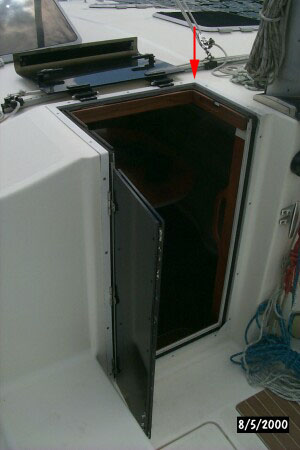 As conceived, the horizontal areas of frame are supposed to drain via a U channel that runs along the periphery of the frame. The channel is about ½" deep and wide, more than adequate to deal with the usual installation tolerances, boat trim issues, and/or deluges of water. That is, unless you own our Prout Catamarans Escale.
As conceived, the horizontal areas of frame are supposed to drain via a U channel that runs along the periphery of the frame. The channel is about ½" deep and wide, more than adequate to deal with the usual installation tolerances, boat trim issues, and/or deluges of water. That is, unless you own our Prout Catamarans Escale.
The corner highlighted in this picture is the lowest point in the frame. Unfortunately, the frame is so bent that the walls of the water channel in this corner are lower than base of the channel where it meets the cockpit wall. Thus, any water that rains onto the door hatch will flow to the side and then accumulate in the channel. From there, it overflows into the cabin since the channel cannot not drain externally.
If this sounds familiar, it should be. Our engine compartment also accumulated vast amounts of water since the drain in the cockpit floor was vented right onto the back of the engine instead of overboard. While the damage due to the cockpit drain omission was much worse than what we were about to discover, it is once again indicative of Prout Catamarans quality control.
It is unclear if the door frame was installed this way to conform it to the
surfaces around it or if the cutout hole was simply too small and the frame
was forced in. Whatever the cause, the door frame does not feature square corners.

Here is a close-up of the port part of the frame. Note the U-channel in the frame (white) and the Teak wood trim. The rubber in the frame is insulation material I installed to reduce water ingress prior to our repair.
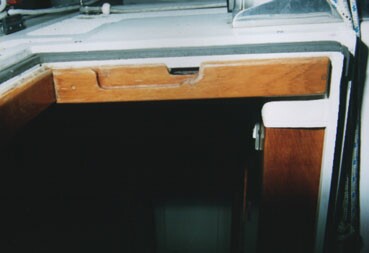 The front edge (left) is lower than the rear (right). |
This picture illustrates beautifully how bent the frame really is. Note how the vertical and horizontal sections of the frame come together in a diamond pattern instead of square as one would expect.
Herein lies the probable explanation of the companionway installation: Instead of installing the frame square, the assemblers opted for a sleeker look by following the hull shape... So if the roof section of the hull where the door is installed does not come to a square intersection with the cockpit wall, then the companionway will mimic that non-square shape as well.
Form over function, I guess.
Note: Even though the installers seemed to follow the hull shape in general, the starboard side of the frame is the lower than the port side, even though the hull roof is "higher" on the starboard side.
We decided to remove and study the headliner first to see where the water that leaked onto the circuit breaker panel had flown from. After all, a hatch leak was possible, even though we suspected the companionway as the most likely culprit (at lot the hatches were installed on level sections of hull that were raised a bit off the surrounding hull. Thus, water would have a tendency to roll away from the point where the hatch and the hull met.
Furthermore, we had observed leakage around the companionway during thunderstorms and had reported that to Prout. But the drops that made it into the cabin were not that significant and easily contained with a sponge. We didn't realize that most of the water was going elsewhere (see below!).
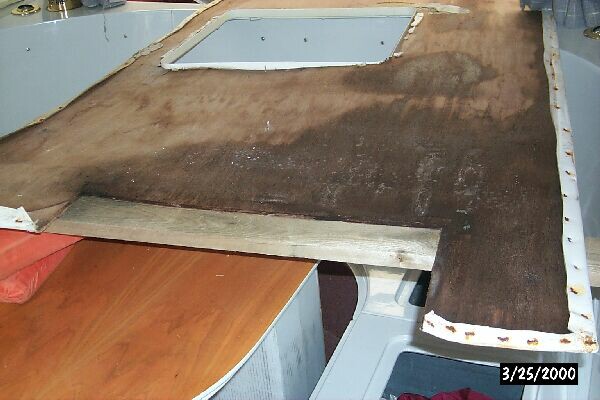
Much to our dismay, the entire 8'-4' headliner had been water-logged and many parts were soft with rot. Evidently, the giant headliner had acted as a huge sponge, absorbing all the rainwater until the tropical storm caused it to spill over. Luckily, this was the last panel to be installed - it didn't overlap with any other panels and hence damage was confined largely to this panel.
One of our mysteries was now resolved. In 1994, the inside of the boat was very humid and some sections developed mold. Now we understood where the necessary humidity had come from. Essentially, this headliner was a giant humidifier. Its construction explains the reason: it consists of a foam-backed vinyl that is stretched over balsa plywood and stapled in place. The balsa/vinyl contraption is then screwed into the fiberglass roof over the saloon.
The barely visibly glob of glue forward of a 24" ceiling hatch cut-out is actually quite large and represents a last ditch effort by the Prout Catamaran folks to straighten the appearance of the headliner after it had already warped by the companionway leak. This was probably done after Prout tried (unsuccessfully) to stem the inflow of water by adding a drain to the frame. As you will see in the repairs section, the Prout repair consisted of draining the wrong corner of the frame by drilling through the deck.
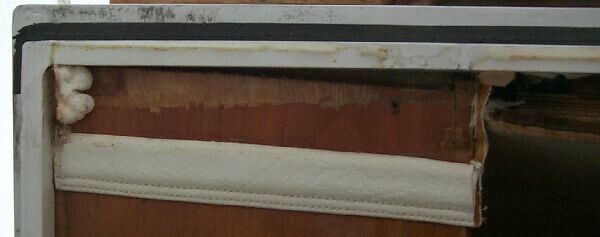
From the condition of the headliner we knew that the water was coming from the frame. We looked at the nice teak trim cover and proceeded to rip it off with a heavy heart - replicating it would not be simple. But the ease with which the teak came off, illustrated the depth of the problem.
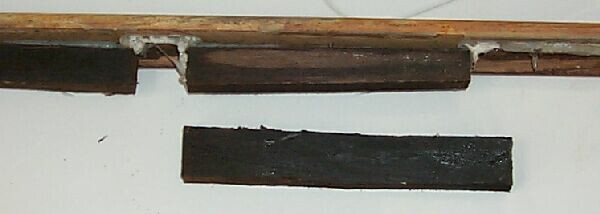
While the teak cover panels had maintained their outwardly good appearance, the plywood sections behind them were basically gone. I was amazed how good the teak looked, yet its softness when we tried to remove it betrayed its rotten condition. Note the very heavy use of silicone. We now realized that besides finding a way to properly drain the companionway we would have to create a new headliner and teak trim.
Best Estimate for Time Required:
| Previous attempts to seal companionway | 2 hours |
|---|---|
| Remove companionway teak, backing wood | 20 minutes |
| Remove headliner next to companionway | 1 hour |
| Total | 3.33 hours |
|---|

